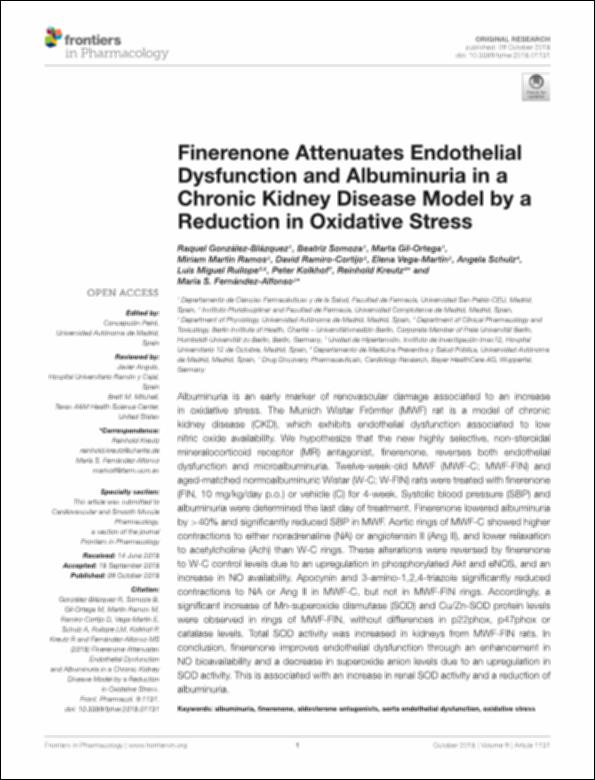Please use this identifier to cite or link to this item:
http://hdl.handle.net/10637/14613Finerenone Attenuates Endothelial Dysfunction and Albuminuria in a Chronic Kidney Disease Model by a Reduction in Oxidative Stress
| Title: | Finerenone Attenuates Endothelial Dysfunction and Albuminuria in a Chronic Kidney Disease Model by a Reduction in Oxidative Stress |
| Authors : | González Blázquez, Raquel Somoza Hernández, Beatriz Gil Ortega, Marta Martín Ramos, Miriam Ramiro-Cortijo, David Vega Martín, Elena Schulz, Angela Ruilope Urioste, Luis Miguel Kolkhof, Peter Kreutz, Reinhold Fernández Alfonso, María Soledad |
| Keywords: | Aldosterone antagonists; Aorta endothelial dysfunction |
| Publisher: | Frontiers |
| Citation: | González-Blázquez R, Somoza B, Gil-Ortega M, Martín Ramos M, Ramiro-Cortijo D, Vega-Martín E, Schulz A, Ruilope LM, Kolkhof P, Kreutz R and Fernández-Alfonso MS (2018) Finerenone Attenuates Endothelial Dysfunction and Albuminuria in a Chronic Kidney Disease Model by a Reduction in Oxidative Stress. Front. Pharmacol. 9:1131. doi: 10.3389/fphar.2018.01131 |
| Abstract: | Albuminuria is an early marker of renovascular damage associated to an increase in oxidative stress. The Munich Wistar Frömter (MWF) rat is a model of chronic kidney disease (CKD), which exhibits endothelial dysfunction associated to low nitric oxide availability. We hypothesize that the new highly selective, non-steroidal mineralocorticoid receptor (MR) antagonist, finerenone, reverses both endothelial dysfunction and microalbuminuria. Twelve-week-old MWF (MWF-C; MWF-FIN) and aged-matched normoalbuminuric Wistar (W-C; W-FIN) rats were treated with finerenone (FIN, 10 mg/kg/day p.o.) or vehicle (C) for 4-week. Systolic blood pressure (SBP) and albuminuria were determined the last day of treatment. Finerenone lowered albuminuria by >40% and significantly reduced SBP in MWF. Aortic rings of MWF-C showed higher contractions to either noradrenaline (NA) or angiotensin II (Ang II), and lower relaxation to acetylcholine (Ach) than W-C rings. These alterations were reversed by finerenone to W-C control levels due to an upregulation in phosphorylated Akt and eNOS, and an increase in NO availability. Apocynin and 3-amino-1,2,4-triazole significantly reduced contractions to NA or Ang II in MWF-C, but not in MWF-FIN rings. Accordingly, a significant increase of Mn-superoxide dismutase (SOD) and Cu/Zn-SOD protein levels were observed in rings of MWF-FIN, without differences in p22phox, p47phox or catalase levels. Total SOD activity was increased in kidneys from MWF-FIN rats. In conclusion, finerenone improves endothelial dysfunction through an enhancement in NO bioavailability and a decrease in superoxide anion levels due to an upregulation in SOD activity. This is associated with an increase in renal SOD activity and a reduction of albuminuria. |
| URI: | http://hdl.handle.net/10637/14613 |
| Rights : | http://creativecommons.org/licenses/by-nc-nd/4.0/deed.es OpenAccess |
| ISSN: | 1663-9812 |
| Issue Date: | 9-Oct-2018 |
| Center : | Universidad San Pablo-CEU |
| Appears in Collections: | Facultad de Farmacia |
Items in DSpace are protected by copyright, with all rights reserved, unless otherwise indicated.


